WB6ZQZ Elecraft K2 Pages
Elecraft K2 Lithium Polymer Battery Conversion
Document version 1.24 4/05/2004
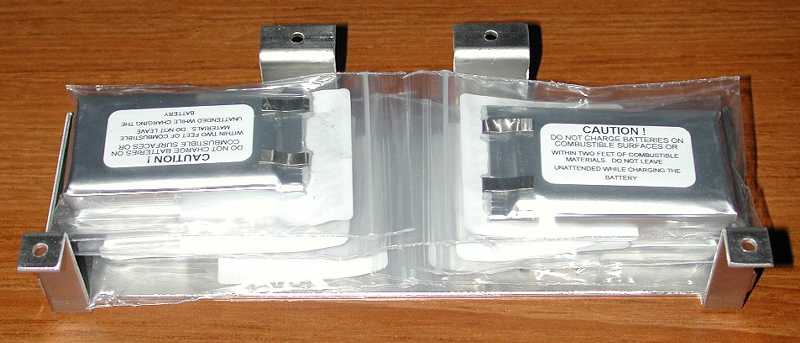
LiPo Cells new in their baggies on the K2 battery tray
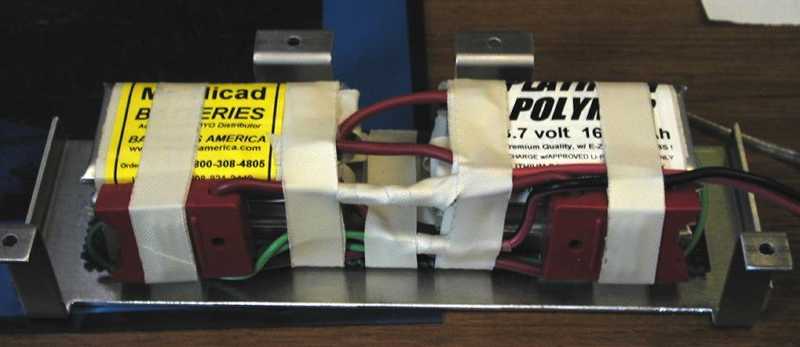
Completed pack, fuse side, red blade fuse holders on each stack
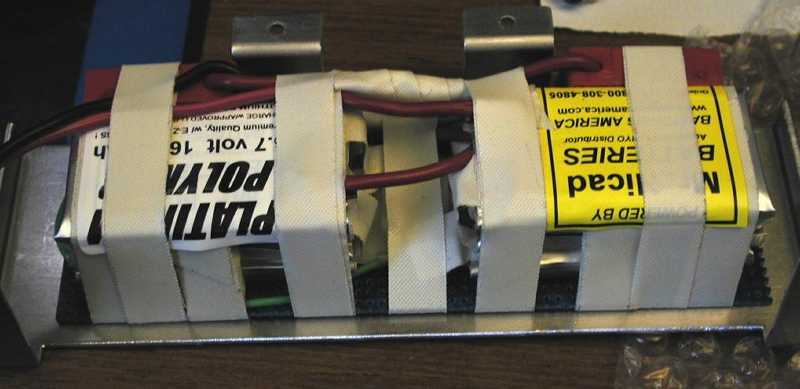
Completed pack, non-fuse side, white tape is fiberglass electrical tape
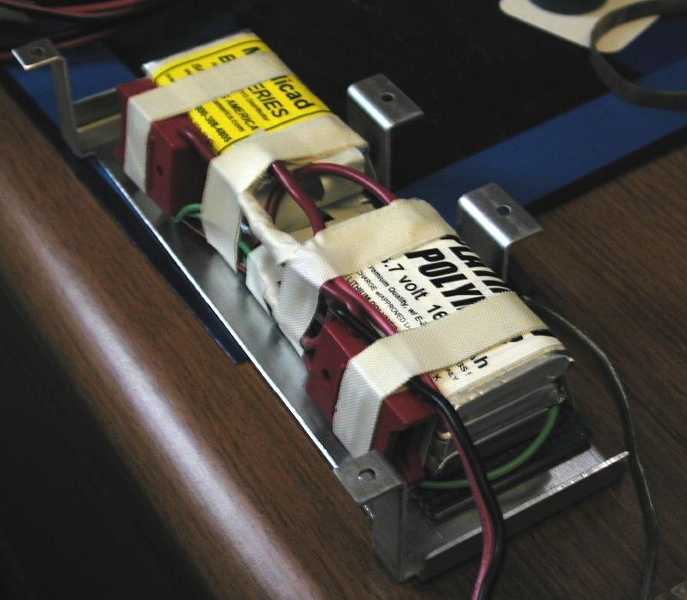
Completed pack, corner view
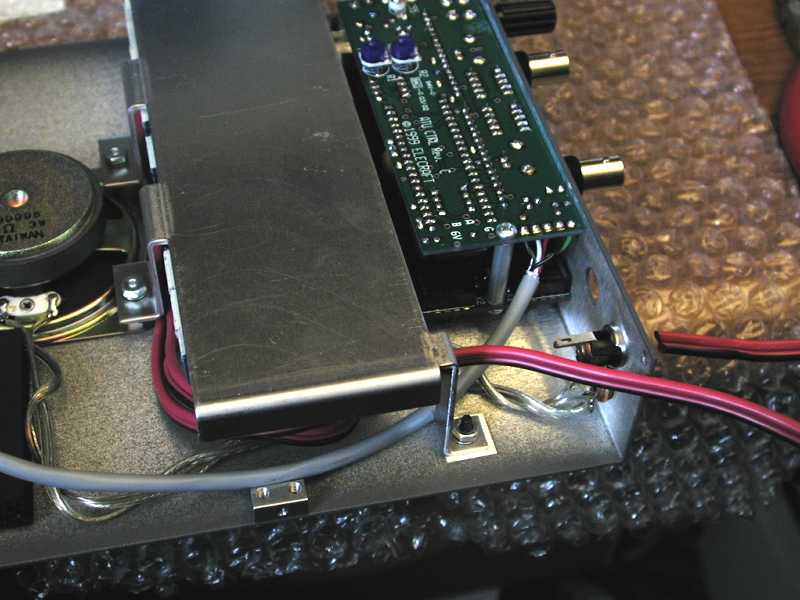
Completed pack installed in K2 lid adjacent to internal tuner
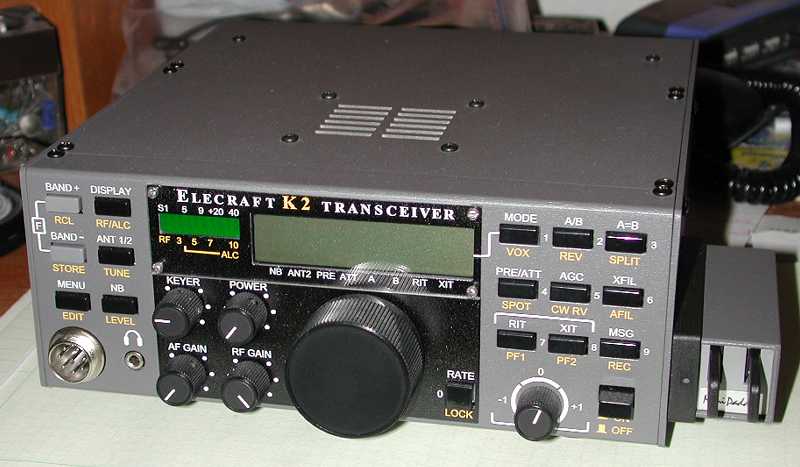
View from the front with Lithium Polymer Power
An Update on the K2 Internal Lithium Polymer Battery project (11/2003)
My goal is to have batteries that are capable and light and fit on the K2 battery tray.
I tried some Li-Ion cells, but they just did not fit readily on
the tray. I purchased the K2 internal battery kit mostly for the
battery tray and hardware to support the batteries inside the case. I need
the system to be lightweight and fairly rugged for HF portable use such as HFPack (See link below).
I think the K2 is under-rated as a lightweight self contained HF ultra portable rig. It offers performance considerably beyond the small lightweight competition. I just weighed my K2. Complete with the internal Lithium Polymer batteries described below, and the internal tuner, Palm Paddles, internal DSP, SSB, etc it weighs under 4.5 pounds!! I believe this is less than the Yaesu 817 with batteries and an external autotuner!! The 817 has a very heavy steel case and heavy NiMH batteries. The K2 has much lower receive power consumption than the Yaesu and with a 3200 milliampere hour battery will outlast the Yaesu internal batteries (in most scenarios) and run at least 3db more power and even more effective power due to the K2's speech processing. The K2 is a much better CW rig and the available integrated DSP is excellent. The K2 is a great portable self-powered HF station. Add a Buddipole or a wire antenna and you've got a complete HF system well under under 10 pounds! Plus the K2 is retro-fittable for 60 meters, which is a great band for HF portable operation!
The Lithium Polymer battery pack saves nearly two pounds in total weight over the factory SLA (sealed lead acid) batteries. The PowerSonic SLA weighs 2.2 pounds, and the LiPo's 8 ounces, so the difference is about 1.7 pounds. The current capacity and energy capacity of the LiPo is higher and the self discharge significantly lower. Self discharge is rated at 95% retention after six months standing. The LiPo batteries are rated for 600 full discharge cycle lifetime (retaining 80% capacity) which is more than SLA batteries are rated to last.
I first tried some of the Lithium Ion packs intended for outboard Digital Camera
power. They are not very compatible with the physical space available on the
K2's battery tray. Lithium Polymer cells are available in a wide variety
of physical sizes. They are generally rectangular, packaged in aluminized
mylar or something similar. I looked at quite a few before settling on
a combination that fit on the tray. To get enough current capacity and voltage,
while still meeting the mechanical size requirements, I had to use two paralleled
stacks of three series cells.
The LiPo cells, available from batteriesamerica.com (link below) and others are quite interesting. The 1600 mah size (P611 3.7v 1600mAh 2.35"L x 1.3"W x 0.33"thick 34 gms (1.2 oz) $12.95 ea) will easily fit on the K2 battery tray (2.4x1.3x7). In fact two sets of three will easily fit and provide 11.1v at 3200 mah with weight under 8 oz. They can provide over 9A of current, so the K2's transmit demands will not be a problem. According to the LiPo users manual from Kokam at fmadirect.com (link below) the cells can be paralleled if the charge capacity and charge state are the same, so I plan to make two series sets of 3 cells and parallel those. I plan to use 4 or 5 amp fuses in each series set to protect against problems. USE FUSES WITH THESE BATTERIES.
There are many warnings regarding Li-Ion and Li-Polymer batteries catching fire (remote chance), etc, if they are abused. From what I've read it seems that the Lithium Polymer cells have much less tendency to misbehave than the regular Lithium-Ion probably due to the minimal gel electrolyte they contain. It is very important to use the proper charging equipment and insure they never get charged incorrectly to avoid battery capacity reduction. Various laptop manufacturers have had some trouble with this, but generally they do not seem to burst into flames when the system is designed properly. Even during destructive testing the LiPo cells merely swelled up and lost most of their capacity unlike their Li-Ion cousins that have been known to get very hot and (in some laptops) catch fire. Considering that all laptops for many years have had this battery technology it has proven to be quite safe and reliable in general. If there really was a safety issue they would ban them from airplanes.
My plan is to develop some confidence in this new pack by charging and discharging it externally from the K2 once or twice just to make sure all is copacetic before charging them internally.
I also plan is to use commercial chargers (at least initially), external from the K2, and insure that the Lithiums never get accidentally charged from any other source. Oliver KB6BA recommends using a separate jack on the rear of the K2 to bring power in and out of the internally mounted LiPo battery. A short jumper is used when powering the K2 from this battery, and the connector he used on the rear panel from the Li-Po batteries is not the same diameter as the K2's power connector, so the only cables that fit to the Li-Po's are the two specific ones - the charging cable and the jumper to run the K2. I will probably use this technique also.
To charge the Li-Po batteries Oliver KB6BA found an excellent small portable 12v to LiPo charger for 1-4 cell packs made by Kokam (link below). I think I will start out with the MaHa C777 Plus II that I already have, which has Li-Ion capability, and then perhaps later move up to the Kokam or my own internal design.
Why use 3 cells? I looked at using four cells but ran into several problems. At full charge they can put out 4.2 volts per cell, or 16.8 volts. This is a bit hot for the K2. A stack of four cells would be very tight on the battery tray - it might not fit. The K2 does not require high voltage - it will run full power down to 10 volts - and the Lithium Polymer batteries deliver virtually all their power from 12.6 down to 10.0 volts. So 3 cells seems to be a 'fit'.
The batteries are on order...
Installing The Lithium Polymer batteries (12/2003)
In a few days the lithium polymer cells arrived. I installed them inside my K2 in December, as the photos above show. By now (3/2004) I've cycled them a couple of times, at least partially. They work very well and provide nominally 11.1 volts at 3.2 amp hours, fit on the standard battery tray, and weigh 7.2 ounces plus a bit for tape, wire, perf board and fuse holders. If you want a lightweight K2 that has internal power, over 3 amp hours of it, this is a great modification. Perhaps Elecraft should have a kit for this!
I used six www.batteriesamerica.com cells as planned. Each P611 cell is rated 3.7 volts 1.6 amp hours at 1.2 ounces and cost $13. Their current online catalog as I write this (3/2004) lists an improved model number LP1700 that has increased current capacity at 1.7 amp hours but is otherwise the same. The size of these cells is 2.35 by 1.3 by .33 inches. Two stacks of three each of these cells fit easily in the battery area of the stock K2 battery tray on a piece of perf board which is fastened to the K2 tray with 3M foam double-sticky tape at each end and in the middle.
I started by purchasing the battery kit from Elecraft without the battery. Out of this kit I only used the aluminum battery tray and some hardware (Elecraft could sell a mini-kit for this). I was planning to use the switch but did not as I don't want any chance of either over-discharging the batteries or accidentally charging them excessively with DC power connected to the rig. So I used a coaxial jack on the back to bring the DC out and a jumper cable to bring it back in. That guarantees that there will never be mistakes.
I built my pack on a piece of perf board a little smaller than the size of the K2 battery tray. One cell at a time I taped the cells into two stacks, carefully soldering the tabs and then covering them with tape, then adding the next cell. Remember that this is 'hot' work (power wise), there is no way to safely discharge the cells and they can deliver very high current if shorted, potentially destroying themselves. I covered the other terminal when soldering a terminal so there was no chance of getting a short. This is important.
The tape I used is white fiberglass electrician's tape. This tape cannot stretch like black electrical tape due to the fiberglass fibers, so it may be a better choice for holding these cells in place. It is available from companies that sell toroidal cores as it is used for holding wires in place.
So now I had two 11 volt stacks. I connected an automotive type blade fuse holder to each stack (no fuse installed), paralleled the other end of the fuse holder wires, and routed the ground and +11v lead to a coaxial power connector on the back of the lid in one of the transverter holes. I used a different size than the radio's coaxial power connector to prevent accidentally plugging in a 12vdc power supply directly across the batteries. The connector I used is a 5.5 mm OD by 2.5 mm ID
coaxial power connector, model 274-1576. It requires slight reaming of the hole
to fit properly and is a sturdy metal connector. After completing installation I installed 4 amp blade fuses into the holders. MAKE SURE YOU FUSE THESE BATTERIES.
I made a jumper cable to go from the new coaxial power out connector to the K2's usual power in connector. I disconnect this cable when transporting (or otherwise not using) the K2. It is important to not 'accidentally' drain down the LiPo batteries as they will be injured - reduced in capacity - if drained below 2.5 volts per cell.
Another way to do this now is to buy two of the 3 cell packs from batteriesamerica.com and make a wiring harness. I recommend this but have not tried it. If I were starting now I would probably try it. The 3LP 1700 pack is 11.1 volts 1.7 amp hours at $48, 2.35 by 1.3 by 1.0", 3.6 ounces. So it is exactly what I did with tape and solder, but already done. Two of these will fit on the K2 battery tray. You can probably obtain the compatible connectors and build a wiring harness without doing any electrically 'hot' soldering as was required the way I did the job. So the cost is slightly higher but there is no hot work and the resulting pack will look more professional. If the batteries need to be replaced it will be much easier - just unplug them.
Charging LiPo Batteries
I have read many specifications on charging LiPo batteries. All the published charging information I have found indicates a very simple charging methodology, but it is quite different from NiCad, NiMH, etc, so is not well suited to those chargers.
Use only LiPo or Li-Ion chargers on these batteries!!! The charging paradigm is PRECISE FIXED VOLTAGE with a current limit. The number quoted by different manufacturers varies slightly, but it is in the neighborhood of 4.2 to 4.235 volts per cell. Batteriesamerica calls for 4.23, Kokam calls for 4.235 within one percent. DO NOT OVERCHARGE WITH EXCESSIVE VOLTAGE OR CURRENT. Make sure you use a charger that is designed to handle 3 cells in series. The current drops off when fully charged. They will apparently not overcharge if the voltage is correct.
The Batteries America literature recommends 4.23 volts maximum charging voltage and 2.5 volts minimum. DO NOT DRAW BELOW 2.5 VOLTS as the cells will be damaged. It is best to stop discharge at 3 volts per cell, or 9 volts in this three in series configuration. Charge only when battery temperature is between 0 and 45 degrees Centigrade. Charge current to be limited to cell capacity (C), or 3.2 amps for this pack (1.6 amps per side, two in parallel). This is a maximum and can be reduced, DO NOT EXCEED THIS CURRENT DURING CHARGING. When charge current drops below 0.1C at the rated charge voltage, which in this battery is 0.32A or 0.16A per side the charge is considered complete. Charging at the 1C rate takes about 80 minutes for a fully discharged battery.
The easiest plan is to buy a MaHa or KoKam charger designed for Lithium Ion batteries (LiPo is a particular variety of lithium ion).
I am using the "MaHa C777 Plus II" which has a Li-Ion charging mode. The first time I charged them I used clip leads. When disconnecting I touched the wrong thing and the 4 amp blade fuses lit up like flashbulbs. These batteries can really put out current. USE FUSES. DO NOT CHARGE WITH CLIPLEADS THAT CAN SHORT. I made up a charging cable (which was always the plan) that has the connection points separated so I can use the MaHa clip leads safely.
Oliver KB6BA suggested the use of separate power connectors for the battery. He used larger cells in his K2 but they did not fit on the battery tray, so mounting was more interesting, as I understand it.
More Information
The Kokam literature on Lithium Polymer batteries is extensive and downloadable in pdf format from the fmadirect website. See the link below and take the "Support" link from the Kokam-FMADirect website.
Future Plans
The next step is to get rid of the battery to radio jumper cable. It works fine but is one more thing to keep track of, and there is a simple way to avoid the cable and still guarantee that the LiPo batteries don't get charged from the rear panel 12 volt input. It is really quite simple (meaning I should have done it in the first place). Wire battery to fuse to switch to diode to battery input connector on the RF board. There will still be one diode drop from the LiPo batteries to the K2 power bus, just as there is coming in through the back panel. The very nice recessed battery switch in the back panel will work. The rear panel jack will still be used for charging.
I also know how to easily get rid of the diode drop from the LiPo battery to the K2 power bus but still maintain protection against charging from the rear 12 volt input. However I will save that little project for later... Or you can use one of the new diodes from the B model upgrade to reduce the drop from about 0.6 volts to about 0.2 volts at 4 amps. Check out the 95SQ015 diode!
It would be nice to have a built-in charge system. It would need to limit the maximum voltage across the cells to 12.690 to 12.705, and limit the current to 3.2 amps or a bit less. One to two amps would be fine for most purposes. It should also protect the batteries against excessive discharge, cutting them off at 9 volts. The rear switch could be used as a battery disconnect, preventing both charging and discharging when opened. It should not generate significant RFI when operating and should only charge when the source voltage exceeds 12.0 volts. Since the charger is mounted inside the radio it should be very lightweight and not generate excessive heat. It could use the top cover as a heatsink. One component that could be used as part of this charge and discharge control system is a "Safety Guard" such as Kokam makes. This unit limits the voltage to a safe range, disconnecting the battery in both over and undervoltage conditions. It does not limit the charging current, however, so this must be accomplished by other means.
An easier way to handle the charging is to get the Kokam Lipo-403 charger. This unit operates from 12 volts and has settable current limits and automatic voltage selection. This unit must use an internal switcher to boost the voltage for charging so it may produce some RFI. This would not be a problem if charging was completed while the radio was offline. On advantage of this technique is the weight of the charger is not added to the radio. As Lithium chargers go, the Kokam is extremely small, lightweight and capable. Other Lithium rated chargers should also be fine, as long as they are rated for three cells in series and can be set for a charge current in the range of 0.5 to 3 amps. Less than 0.5 amps would take a very long time, and more than 3 amps is too hard on the cells.
-- Alan WB6ZQZ
WB6ZQZ Elecraft K2 Home Page
WB6ZQZ Home Page
You may email author Alan Biocca via wb6zqz at arrl.net





